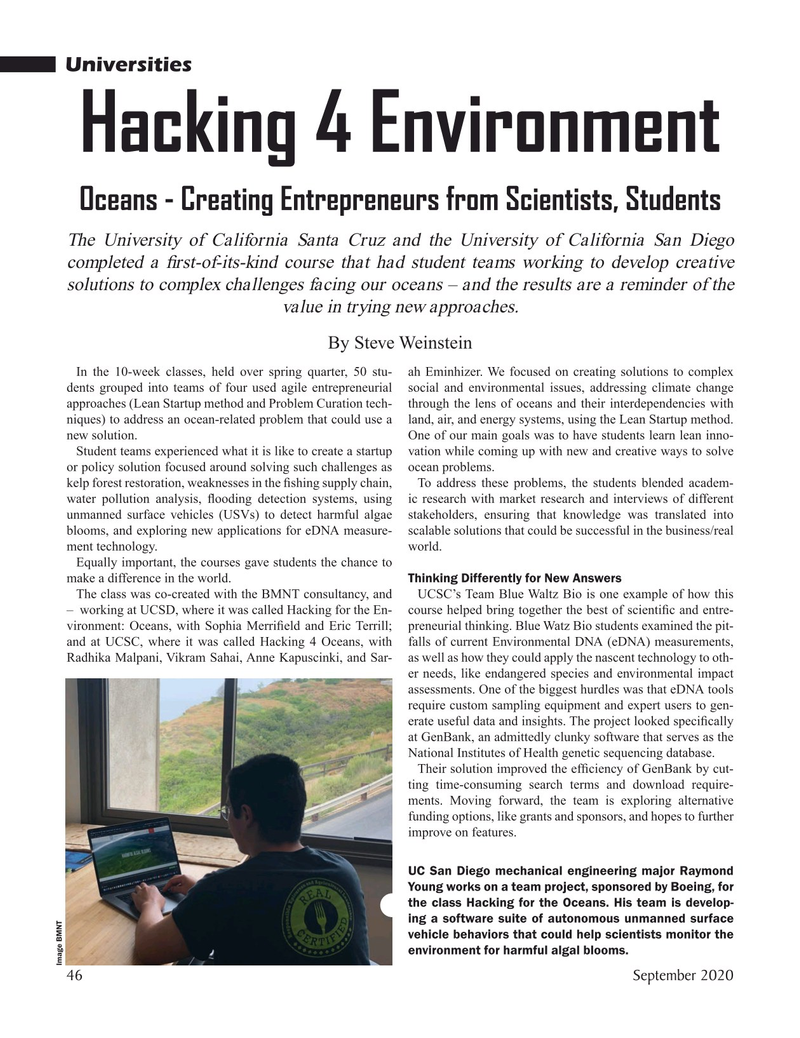
Page 46: of Marine Technology Magazine (September 2020)
Read this page in Pdf, Flash or Html5 edition of September 2020 Marine Technology Magazine
Universities
Hacking 4 Environment
Oceans - Creating Entrepreneurs from Scientists, Students
The University of California Santa Cruz and the University of California San Diego completed a ? rst-of-its-kind course that had student teams working to develop creative solutions to complex challenges facing our oceans – and the results are a reminder of the value in trying new approaches.
By Steve Weinstein
In the 10-week classes, held over spring quarter, 50 stu- ah Eminhizer. We focused on creating solutions to complex dents grouped into teams of four used agile entrepreneurial social and environmental issues, addressing climate change approaches (Lean Startup method and Problem Curation tech- through the lens of oceans and their interdependencies with niques) to address an ocean-related problem that could use a land, air, and energy systems, using the Lean Startup method. new solution. One of our main goals was to have students learn lean inno-
Student teams experienced what it is like to create a startup vation while coming up with new and creative ways to solve or policy solution focused around solving such challenges as ocean problems.
kelp forest restoration, weaknesses in the ? shing supply chain, To address these problems, the students blended academ- water pollution analysis, ? ooding detection systems, using ic research with market research and interviews of different unmanned surface vehicles (USVs) to detect harmful algae stakeholders, ensuring that knowledge was translated into blooms, and exploring new applications for eDNA measure- scalable solutions that could be successful in the business/real ment technology. world.
Equally important, the courses gave students the chance to make a difference in the world. Thinking Differently for New Answers
The class was co-created with the BMNT consultancy, and UCSC’s Team Blue Waltz Bio is one example of how this – working at UCSD, where it was called Hacking for the En- course helped bring together the best of scienti? c and entre- vironment: Oceans, with Sophia Merri? eld and Eric Terrill; preneurial thinking. Blue Watz Bio students examined the pit- and at UCSC, where it was called Hacking 4 Oceans, with falls of current Environmental DNA (eDNA) measurements,
Radhika Malpani, Vikram Sahai, Anne Kapuscinki, and Sar- as well as how they could apply the nascent technology to oth- er needs, like endangered species and environmental impact assessments. One of the biggest hurdles was that eDNA tools require custom sampling equipment and expert users to gen- erate useful data and insights. The project looked speci? cally at GenBank, an admittedly clunky software that serves as the
National Institutes of Health genetic sequencing database.
Their solution improved the ef? ciency of GenBank by cut- ting time-consuming search terms and download require- ments. Moving forward, the team is exploring alternative funding options, like grants and sponsors, and hopes to further improve on features.
UC San Diego mechanical engineering major Raymond
Young works on a team project, sponsored by Boeing, for the class Hacking for the Oceans. His team is develop- ing a software suite of autonomous unmanned surface vehicle behaviors that could help scientists monitor the environment for harmful algal blooms.
Image BMNT 46 September 2020
MTR #7 (34-49).indd 46 9/11/2020 9:48:20 AM

 45
45

 47
47
